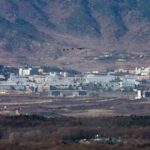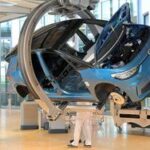
“Pay with Your Face: Indulging in the Taste of Existential Fear,” the American-style lunch infused with a flavor of existential dread.
International media outlets like The Guardian and Forbes recently covered the debut of CaliExpress by Flippy. This fully autonomous AI-based burger restaurant opened in the United States on April 18th.
Coinciding with implementing a new $20-an-hour minimum wage for fast-food workers in California on April 1st, a new restaurant with noticeably fewer employees opened in the northeast of Los Angeles.
Located near California’s Caltech University in Pasadena, this restaurant is powered by technology from Miso Robotics, the creators of Flippy, the AI-based robot fryer, and PopID, a company that simplifies orders through biometric recognition.
Miso Robotics, the brains behind Flippy responsible for making fries, is a local startup founded by a group of Caltech graduates.
This restaurant claims to be the ‘world’s first’ fully autonomous eatery, using AI-based robotic systems to produce fast-food burgers and fries. While a few staff still need to press buttons on the machinery and assemble burgers and toppings, associated companies are promoting significant labor cost savings by utilizing their technology. Their pitch? “Eat the future.”
Inside the restaurant, a massive poster advertises the “AI Robot Marvel.” The space features early prototypes of robotic arms and a nod to Michelangelo’s Sistine Chapel, with one notable difference: instead of human hands reaching towards God’s, robotic claws clutch the fries.
A robot-made cheeseburger and fries cost approximately $15, excluding tax. Orders are placed via self-service screens, prompting patrons to consider registering with PopID to link their face to a credit or debit card for a $10 incentive. The prompt reads, “Pay with your face!” followed by, “Pay with a smile!”
This burger restaurant emerged from a collaboration among various companies eager to explore the future of fast-food technology. The burger-making machines are produced by Cucina, a company specializing in food production automation. They propose that Burger Chef is the solution to a 65% wage increase for restaurant workers over the past 15 years.
Upon receiving an order, the burger chef grinds a Wagyu steak, extrudes it from a tube, and grills it between two metal plates until brown. After 195 seconds, a plastic arm rotates to retrieve the cooked burger, and the meat drops into a waiting container. The burger chef is bulky equipment, hardly captivating to watch.
However, Flippy is the true star of this restaurant.
With its sizeable snake-like arm extending from the ceiling, Flippy takes its place above a protected frying pan behind a transparent window. Pressing the button once more swiftly raises its arm to fetch the waiting metal frying basket, moving it to one side before dropping a predetermined amount of frozen potato slices. Flippy then submerges the basket into the sizzling oil. It’s a humanoid robot arm that might be slightly unsettling.
Flippy was initially conceived as a grill master robot for flipping burgers. However, managing a grill that can track burgers, cheese, bread, and onions and flip various items at the right time proved to be an immensely complex robotics problem, too daunting for startups to tackle.
Eventually, Miso Robotics pivoted to a more straightforward challenge: creating a robot to manage the frying station. Companies describe this task as favorable for robots because it’s one of the most stressful and hazardous tasks for human workers in the kitchen. Robots are immune to burning in hot oil or being hindered by heat.
Moreover, Flippy also boasts AI computer vision, utilizing machine learning and neural networks to enable computers to process visual inputs like photos and videos in a manner akin to human visual perception. Flippy’s computer vision continuously monitors the location of the frying basket, allowing the machine to easily adjust even if human workers replace the basket in a slightly different position.

The robot is not limited to fries, it can also fry chicken wings and onion rings, and can adjust the frying time automatically when it senses that it’s not potatoes but onions in the fryer. Essentially, Flippy was designed not to replace human workers entirely but to make their work easier and safer.
While Flippy’s interface is designed to be very simple, human employees need to be familiar with its operation, cleaning procedures, maintenance, and how to contact robot support lines when necessary. Additionally, the robots cannot repair or clean themselves. Human employees must clean the robots daily and focus on more intensive cleaning monthly or quarterly.
The taste of the burgers made by the robot is mainly described as “ordinary.” However, let’s not overlook that Flippy’s fries are crispy and brown, unlike the typical soggy fries often found in fast-food joints.
If you order a burger through a McDonald’s drive-thru, a freshly made burger by humans will be in your hands in less than two minutes.















Most Commented